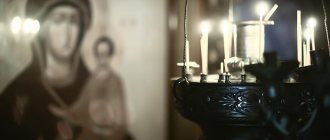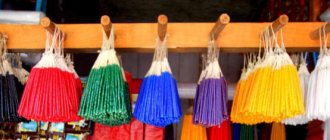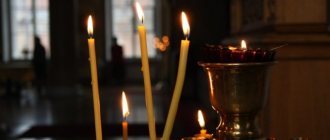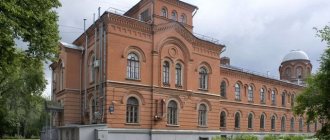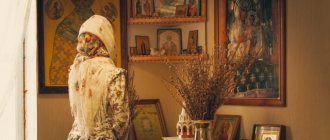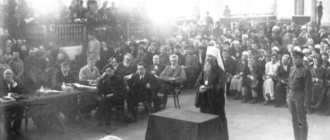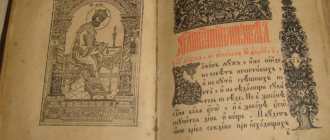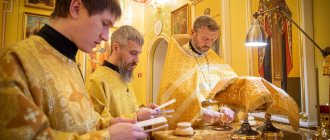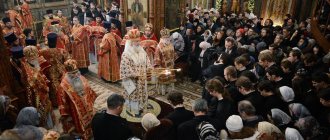Purpose of the lamp
A burning lamp represents a person’s heart burning with prayer and faith. The first mention of them is found in the Old Testament. They stood in the Tabernacle of the Covenant, where there was an Ark with the most expensive objects reminiscent of the miracles of God (a vessel with manna from heaven, Aaron's rod that blossomed, etc.) The Jews were very reverent towards the Tabernacle, as well as everything that was connected with it . Therefore, lamps were sacred things for them.
Nowadays, the lamp has more of a household character. Some people prefer to have them at home, but rarely light them, not seeing much point in it. And some believers do without them altogether.
Device
Essentially, a lamp is an improved candle. One option is a container with paraffin, usually a glass (crystal) cup, on a stand. Reusable use is ensured by simple replacement of flammable material. This is typical for desktop products. The stand is metal with a border and shaped legs, often decorated with symbols of the Christian faith. Replaceable cups, different colors:
- red - for Easter time;
- green – for daily use;
- blue, purple or colorless - for Lent.
Oil lamps are supplied with wicks. They can be of different designs:
- A thin plate with a small hole in the middle for a wick. It is placed on the surface of the oil, one end of the wick is above the plate (the length of no more than one or two match heads), the second is lowered into the oil.
- The Greek design is a cork float with a solid wick stuck through it.
The operating principle is the same. The design provides the most comfortable conditions for long-lasting flame maintenance. Wide short candles are used in lamps for religious processions. They are inserted into an oblong-shaped vessel, closed on top with a tin lid with holes. This shape allows the flame to burn long and evenly.
Why light a lamp in front of icons?
Lighting a lamp in front of the icon reminds believers of the bright deeds of the saint depicted on it. The light of this church lamp also reminds us of the light that God has endowed on the souls of people. And a lamp lit according to all the rules drives away the forces of evil. During prayer, they can divert the thoughts of the praying person from the very essence of offering praise. But the light of the lamp does not allow this to be done.
The light of the burning lamp in front of the icon is also a small sacrifice for the fact that the Savior gave his life for people. The light of a lamp reminds us that without a person it cannot flare up, just as without faith in God a person’s heart cannot flare up. But the fire in the lamp must be lit correctly. And there are special rules for this.
Story
The first lamps are primarily lamps. The word itself is of Greek origin. The literal translation is “a lamp burning before the saints.” Initially, they were actually used for lighting in dark caves by the first Christians. There they held their services, hiding from possible pursuers.
Gradually, lamps became the most important detail of the decoration of the temple and an attribute of some church rituals. The premises of almost any church are quite light during the day, but it is impossible to find a building without burning candles or lamps. This evokes in the souls of believers a certain mood for communication with the Almighty. It doesn’t matter for what purpose you visit the temple: to pray for health or peace of soul, to repent or to thank God. Anyone who enters here will definitely light a candle, a symbol of faith in God.
Symbolism of candles and lamps in Orthodoxy
The Law of God, given to the people of Israel in the Old Testament, contributed to leading a godly life. Therefore, an unquenchable lamp always burned before the book of the prophet Moses. For Christians, the Gospel contains the Law of God. In the first centuries, the Church of Jerusalem developed a tradition: to carry a lighted candle in front of the Gospel, which is taken out of the altar during worship. This symbolically indicated that the light of the Gospel teaching should enlighten every person. Over time, this tradition passed on and became entrenched in the liturgical life of other Local Churches.
Why are lamps placed in front of the icon?
St. Nicholas of Serbia explained very precisely why lamps are installed in front of the icon. First of all, according to him, faith is light, and lamps remind us of the pure light with the help of which our Lord Jesus Christ warms and heals human souls. In addition, they are symbols of the bright character of the saints in front of whose faces they are installed. They also remind people of their sinful thoughts and actions, call us to the true path, call us to fulfill the commandments and do good deeds.
Lamps are that “small sacrifice” that a person can make to the Savior because He gave his life for him. During prayer, these lamps drive away the forces of evil. The light of the lamp encourages us to humility and sacrifice, reminds us that just as its fire cannot flare up without human participation, so without God our heart cannot flare up.
Meaning
Lamp from the Greek "lampas" means a portable lamp or a small vessel that contains oil and a wick inside. It is lit in front of the images and the fire does not go out until all the oil is burned.
The lamp is a modified candle whose flame does not go out for a long time.
Initially, the vessels were used simply as lamps, because there was no electricity, and the oil burned out much more slowly than a torch burned out. Such a lamp was used by Christians of the first centuries, since their meetings took place in caves, where it was always dark (persecution did not allow them to gather openly).
As soon as Emperor Constantine allowed Christian services, believers began to hold meetings in churches and the lamp became part of the decorations and attributes of the service. Today it is also used for Christian services in churches.
Interesting! The icon lamp is used by the priest during the liturgy (small and great entrances), as well as during the service of the bishop. The lamp is set on fire by the altar servers or taken to the priest by the deacons.
If initially the vessel was used in worship for its intended purpose - to illuminate a meeting in caves, today it has a more symbolic purpose - it metaphorically depicts the eternal fire of God's love and faith, which drives away the forces of darkness. Twilight in Orthodox churches symbolizes the darkness of human life, and fire is God’s compass, leading people to salvation.
Why are lamps placed in front of the icon?
Since the lamp is a symbol of the eternal flame of God’s love, it must burn constantly in the temple. At home they light it during prayers or for the entire time, provided that there is someone at home. Why this is necessary was explained very well by St. Nicholas of Serbia. He said that faith is light, and the fire in the vessel is a reminder of this light to man.
A lamp burning in front of the image of a saint means sincere gratitude for forgiveness and salvation
In addition, the saint identified several more reasons for the need for fire in front of images:
- Fire is a symbol of the bright character of the saints, in front of whose icons lamps are hung.
- The light shows a person the true path, reminding him that every sin leads him further into darkness. By this, the light calls for repentance and gives hope in the darkness.
- This is a sacrifice for God - the Savior gave his life for a person, the least that a person can return is prayer and oil in a lamp.
- This is a symbol of obedience and humility - just as without a person a fire in a lamp cannot be lit, so without God love and repentance will not awaken in a person’s heart.
- This is a symbol of God’s fire in man - Christ said: “Go and shine before men,” comparing man to a lamp.
By lighting a lamp in front of the icons, a person illuminates the faces of the saints, focusing on them and expressing respect. Looking at its fire, people remember God, have a compass and a guide in this dark world.
When should you light a lamp at home?
They are lit during the reading of prayers, on temple holidays and simply at will. In churches they burn continuously, but change depending on the color, which corresponds to the events of the Orthodox calendar:
- red - on temple holidays and Easter week;
- blue - on fasting days;
- yellow (gold) - on everyday days;
- green - on the holiday of Trinity and Palm Sunday.
The tank is initially fixed in front of the image; if it is suspended, then a pin is first driven into the wall that will support the weight of the lamp. Before the prayer begins, the wick of the lamp is lit from a burning church candle and left to burn while the reading takes place.
The smoldering lamp symbolizes the outlines of Divine light emanating from heaven
In addition to prayer moments, the lamp is lit in front of the images on the days of remembrance of the saints who are depicted on the icons, on Sundays and holidays. While lighting the wick, you can read a special prayer:
Light, O Lord, the extinguished lamp of my soul with the light of virtue and enlighten me, Your creation, the Creator and Benefactor. For You are the immaterial Light of the world, accept this material offering: light and fire, and reward me with inner light to the mind and fire to the heart. Amen.
Kinds
Today you can find lamps of completely different shapes, sizes, types and materials. Its components remain unchanged: an oil reservoir, a stand and a glass to protect the flame. If the lamp is pendant, then most likely it does not have a stand - it is replaced by a decorative element, and there must be three metal cords that hold the tank.
Types of vessels vary depending on the dimensions and methods of their use:
- Tabletop, wall and hanging (used only in churches).
- Extinguishable and inextinguishable (placed in front of relics and relics).
- For home use, temple and church processions.
- Ceramic and glass.
- Made from colored glass or painted.
Closed memorial lamps are lit at the cemetery
You can buy lamps of different shapes and types for home use, but the most convenient are glass table lamps, but you will definitely need to purchase a stand for them (it protects against ignition if the glass cracks). In this case, lamps can be simple or decorated with carvings and paintings.
Content
Priest Andrei Chizhenko explains.
According to Orthodox doctrine, man is a two-part being: spiritual and physical. The soul is the image and likeness of God in man. Through the body, a person connects with the material animal world. This is the great task of man. To deify oneself (that is, to begin the path of ascent to God, the path of knowing Him, uniting with Him, or rather, with Divine uncreated energies) and through deification to deify and sanctify the rest of material nature, since man is its center and king. It seems to exist at the intersection of two worlds - spiritual and material. Based on this, the human body is a collaborator with the soul in the matter of salvation. It is the essence of the temple of God. This is why Orthodoxy treats the body so carefully. This can be seen from the burial order.
Therefore, all Church Sacraments and, as a consequence, divine services also have a dual nature. Example: in the Sacrament of Baptism, the priest invokes the name of the Holy Trinity - this is the spiritual main component. But the substance of baptism is completely material – water. Sacrament of Communion. Its core is the Body and Blood of Christ. And the substances for the Sacrament are prosphora, wine, water. Therefore, Orthodox worship influences the grace of the Holy Spirit not only on the soul, but also on the body. Anointing oil (touch), ringing bells, singing (hearing), icons, painting (sight), prosphora, Epiphany water (taste), burning incense (smell).
The family is a small church. This is also a kind of service to God and one’s neighbors. Naturally, we want God’s grace to sanctify ourselves and our homes, to protect us from all evil and defilement. In addition, in paradise the righteous and holy angels are in continuous worship - the praise of the Almighty. Therefore, with God’s help, we try to continue church services (within reasonable limits, of course) at home. Similar to this is the monastic rite of panagia (from Greek - “all-holy”), when the Mother of God prosphora, from which a piece is taken out in honor of the Virgin Mary at the proskomedia after the Liturgy, the monks solemnly transfer from the temple to the refectory, where they eat it with certain prayers, and then begin meal. Thus, the Liturgy seems to continue, and it continues in the cell conditions of monastic dormitories. In a spiritual sense, approximately the same thing happens to us when we seem to “bring the temple and worship home,” arranging from our lives a worship service, a sacrifice to the Almighty. That’s why, for example, earlier in every Orthodox home there was a “red” (beautiful from outdated) corner where icons were placed, incense was burned, and a lamp was lit. Often it was made to the east, like the altar of a temple. As a matter of fact, the red corner is a kind of home altar. In general, this is a very good tradition. Correct. The family makes a feasible sacrifice to God and arranges a dwelling for Him in their house, and He, of course, settles in it, because the loving hearts of His children long for a meeting with their Heavenly Father.
Read also: How to corral pigs
It is not always possible, of course, to arrange a red corner to the east in modern conditions, but, in principle, every family can do it. This is our expression of love for God. The only thing I would like to say about this from experience... It is still necessary to separate a place in the house for the images of saints, so to speak, to clear it from other worldly things. Otherwise, you often see in houses how icons are filled with glasses or other completely worldly things. Sometimes other involuntary sacrilegious acts occur when icons are placed together with the increasingly popular Japanese netsuke gods, various “money toads” that “bring” wealth and success, or erotic paintings. Of course, this is unacceptable. A person must understand himself, Whom he serves: Christ or Belial. It is better to throw away or burn pagan idols and not keep them at home.
As for the lamp, for example, for me it burns constantly for days. Let us remember the parable of the ten virgins (see Matt. 25:1–13). In my opinion, a burning lamp, caring for it, buying lamp oil, candles for lighting it is our feasible sacrifice to Christ (a kind of tactile prayer to God) and a feasible financial sacrifice to the Church (lamp oil, candles, wicks, the lamp itself). Some people light a lamp before prayer. This is also good and beneficial. God will accept any sacrifice feasible for a person if it is made with reverence and a loving heart. The lamp, of course, is lit in front of the icons.
From my experience I will say that for a lamp it is better to take purified specialized lamp oil. No matter how much I tried to use regular sunflower oil and even refined sunflower oil, it burned poorly, the lamp smoked and became clogged.
As for incense - incense and incense, it is also quite possible to use it at home. You just need to not imitate censing by a clergyman in the temple (this is still the prerogative of the priest), but rather burn incense rather than burn incense with it.
Now in church shops there is a very large selection of both incense and censers. There are special “spiders” - light metal structures that are attached to the lamp. There is a platform on top of them. Incense is placed on it. From the warmth of the lamp fire, the metal heats up - and the incense begins to smell fragrant. There are special stationary censers - clay, porcelain, metal. They need coal. It is lit, placed in a censer, and pieces of incense are placed on top. The lid of this censer has special holes for smoke. You can light censers before prayer, you can walk through the house with the Jesus Prayer or any other prayer, filling its rooms with a heartfelt appeal to God, which rises into the sky as easily as smoke from a censer.
Burnt coals should be disposed of as follows. If you live in a private house, it is advisable to make a hole in clean soil in the front yard or garden, perhaps under a tree or bush, where you can shake out the ashes (including incense) from burning consecrated things. You can throw ashes into running water or into a river. If you live in an apartment, then it is also advisable to burn the remains of consecrated things somewhere in the park or in flower beds, then bury the ashes in clean soil. You can shake out the remains of burnt coal into flowerpots with indoor plants.
What I would like to warn against.
There is no need to turn your entire house into a church. It is important to understand that you should not only pray in the house, but also live. One or two or three places in the house allocated for spiritual needs are enough. Leave space in your home for yourself, your spouse, and your children. Everything is good in moderation.
A church lamp is considered one of the main symbols of a person’s unquenchable faith in God.
In ancient times, Christians illuminated dark caves with it, where local residents gathered to perform Divine services. There they hid from possible attacks from enemies and pursuers.
Later, lamps began to be used as decoration for churches and temples, as well as for various church sacraments.
Read also Marinade for saffron milk caps per 1 liter of water
In simple words, a lamp is a modified candle, the flame of which does not go out for a long time. Depending on the dimensions, methods of use and application, there are several types of lamps:
- table and wall;
- hanging - found only in churches and temples;
- extinguishable;
- inextinguishable (with continuous burning) - located near icons, relics of saints, revered shrines;
- for church processions - short candles of wide diameter are used, inserted into an oblong vessel, which promotes long and even burning;
- for home use.
The main components of the lamp are a paraffin reservoir, a stand of any shape, and a colored crystal glass on it. Red is used for Easter, blue or colorless is used during Lent, green is used daily.
How to light a lamp
Church lamps standing in front of icons in houses may not be constantly burning. They are allowed to be lit in the morning, extinguished when leaving home, and lit again in the evening. Do not use a lighter or match to light the wick. You must first set fire to the consecrated church candle and light the wick from its flame. By the way, there are also special requirements for the wick.
The wick of a church lamp is screwed on so that it does not smoke or go out. Afterwards it is dipped into oil poured inside the lamp. The oil must also be special - olive and bought in a church shop. It must be highly purified. After all, by lighting a lamp, a believer opens his heart to God. And the use of low-grade olive oil indicates a lack of faith.
When lighting the lamp, it is customary to read a special prayer. And if for some reason a believer does not have a lamp at home, then it can be replaced with a blessed candle. You can also pray with a candle in the temple, in front of the icon case.
Oil
Real oil for lamps is wood. This is the name given to a product obtained from the fruits of olives growing on a tree, and not from herbs or seeds. Spruce is considered the purest and highest quality oil of the highest grade. When burning, it does not form soot and does not emit any harmful substances.
Due to its purity and healing properties, oil is used both for anointing the sick and in baptismal rites. Throughout the thousand-year history of Christianity, olive oil was considered a worthy sacrifice to God.
